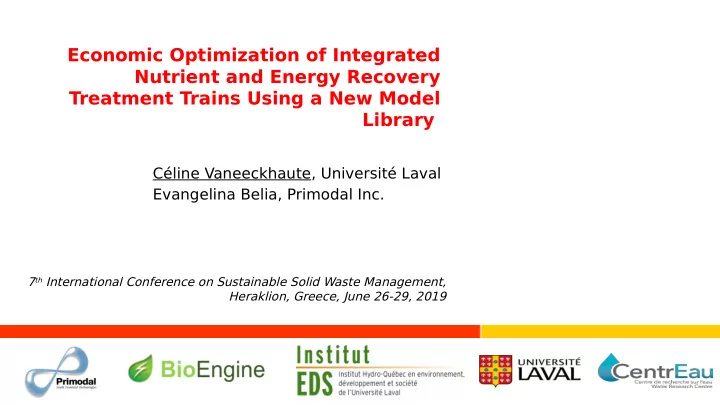

Economic Optimization of Integrated Nutrient and Energy Recovery Treatment Trains Using a New Model Library Céline Vaneeckhaute, Université Laval Evangelina Belia, Primodal Inc. 7 th International Conference on Sustainable Solid Waste Management, Heraklion, Greece, June 26-29, 2019
Outline of the presentation Introduction Nutrient recovery model (NRM) library T reatment train optimization T ake-home message 2 2
INTRODUCTION 3
The nutrient paradox Nutrient excesses Increasing demand for Environment chemical fertilizers Environmental pollution Nutrient depletion (P, K) 4
How to produce more food and energy with less pollution? 5
Nutrient recovery from (digested) waste: A potential sustainable and cost-efgective solution • Precipitation → struvite, calcium phosphates • Ammonia stripping → NH 3 • Acidic air scrubbing → ammonium sulphates • Membrane fjltration → H 2 O, N-K concentrates • Biomass production and harvest → biomass • … ⇒ Mainly physicochemical unit processes ! ⇒ Mainly physicochemical unit processes !
Potential fmow diagram of a biorefjnery for nutrient and energy recovery Problem: Optimal combination difgerent for each waste stream Problem: Optimal combination difgerent for each waste stream Research question: What is the optimal combination of unit Research question: What is the optimal combination of unit processes and what are the optimal operating conditions? processes and what are the optimal operating conditions? Given: Particular waste stream Given: Particular waste stream Optimal: Optimal: • Maximal resource recovery (nutrients, energy) • Maximal resource recovery (nutrients, energy) • Minimal energy and chemical requirements • Minimal energy and chemical requirements Approach = Mathematical models Approach = Mathematical models
Nutrient recovery model (NRM) library 8
Generic nutrient recovery model (NRM) library Modelica language TORNADO/WEST NRM-Prec NRM-Scrub NRM-AD NRM-Strip NRM = Nutrient Recovery Model
Combined three-phase physicochemical-biological models Reactor model Fast reactions Chemical PHREEQC PHREEQC speciation model Challenge = Challenge = Interface numerical solution! numerical solution! Species Species pH pH Slow TORNADO/WEST TORNADO/WEST reactions Physico- Biochemical chemical model model
TREATMENT TRAIN OPTIMIZATION 11
Global sensitivity analysis (GSA) • Selection of factors with the highest impact on model outputs (= objective for further study) • Input waste stream characteristics • Kinetic model parameters • Process operational parameter • …. Acquired understanding Optimal treatment train confjguration Optimal treatment train confjguration
Treatment train confjguration Target = struvite + ammonium sulfate OPTIMAL OPERATING CONDITIONS? OPTIMAL OPERATING CONDITIONS? C-recovery P-recovery N-recovery Use of Chloride inhibition Use of Chloride inhibition Mg(OH) 2 /MgO Phosphate inhibition Mg(OH) 2 /MgO Phosphate inhibition Ca-inhibition Removal of Ca, Fe Ca-inhibition Removal of Ca, Fe Scaling Fe/Al impurities and Al precipitates Fe/Al impurities and Al precipitates Consumables →Costs Recovered products → Revenues
M M I A X N I I M M I I Z Z E E Treatment train optimization 14
Treatment train optimization: Economic analysis Variable costs & revenues Capital costs Variable costs & revenues Capital costs • Heat requirements worst & best case • T echnology providers • Chemicals • CAPDET software • Electricity • Maintenance, material & labor costs • Biogas production electricity and heat • Fertilizer marketing worst and best case • CO 2 emission reduction credits: 15 $ ton -1 15
Treatment train optimization: Economic analysis Financial benefits: ~ variable costs: 5 $ m -3 manure y -1 Optimized 90 $ ton -1 solids y -1 Biorefinery ~ variable + capital costs: 2 $ m -3 manure y -1 40 $ ton -1 solids y -1 Subsidies ZeroCost-Biorefinery (pay-back time: 7 years) Heat balances 16
Take-home message 17
Main conclusions • Generic nutrient recovery model (NRM) library created and validated • Global sensitivity analysis Identifjcation of interaction between processes Optimal treatment train confjguration • Model-based treatment train optimization Valuable tool for evaluation of project feasibility Key factors for design of nutrient and energy recovery facilities: • subsidies • fertilizer marketing potential • heat balances 18
Perspectives: Development of a decision-support tool for optimization of holistic organic waste valorization chains Industry/ Research Government Consultants 19
Further reading 20
Questions ? $$$ Modelling is a must for optimizing the value chain! « Nothing is lost, Nothing is created, Everything is transformed » celine.vaneeckhaute@gch.ulaval.ca https://bioengineblog.wordpress.com/ 21
Recommend
More recommend